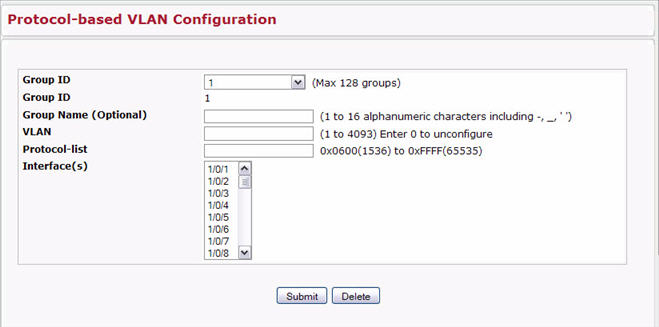In a protocol-based VLAN, traffic is bridged through specified ports based on the protocol associated with the VLAN. User-defined packet filters determine whether a particular packet belongs to a particular VLAN. Protocol-based VLANs are most often used in situations where network segments contain hosts running multiple protocols.
You can use a protocol-based VLAN to define filtering criteria for untagged packets. By default, if you do not configure any port-based (IEEE 802.1Q) or protocol-based VLANs, untagged packets are assigned to VLAN 1. You can override this behavior by defining either port-based VLANs, protocol-based VLANs, or both. Tagged packets are always handled according to the IEEE 802.1Q standard and are not included in protocol-based VLANs.
If you assign a port to a protocol-based VLAN for a specific protocol, untagged frames received on that port for that protocol will be assigned the protocol-based VLAN ID. Untagged frames received on the port for other protocols will be assigned the Port VLAN ID (PVID), which is either the default PVID (1) or a PVID you have specifically assigned to the port using the Port VLAN Configuration screen.
Use the Protocol-based VLAN Configuration page to configure which protocols go to which VLANs, and enable certain ports to use these settings. You define a protocol-based VLAN by creating a group. Each group has a one-to-one relationship with a VLAN ID, can include one or more protocol definitions (the range is platform-dependent), and can include multiple ports.
To display the Protocol-Based VLAN Configuration page, click Switching > VLAN > Protocol-based VLAN > Configuration in the navigation menu.

The following figure shows the page after a group has been created.

Protocol Group Fields
Field |
Description |
|---|---|
Group ID |
Use the drop-down menu to create or modify a protocol group. You can create up to 128 groups. If the Create New Group option is selected, only the Group ID fields are displayed. |
Group ID |
If the Create New Group option is selected in the first Group ID field, enter a number to identify the protocol-based VLAN group. Otherwise, this field shows the ID number of the group currently being displayed or configured. |
Group Name |
When creating a group, enter a name to associate with protocol group ID. You can modify the name of an existing group. You can enter up to 16 characters. |
Protocols |
Specify one or more protocols to associate with this group. The protocol-list can be any valid comma(,) separated string with a standard keyword (below), hexadecimal or decimal values in the range of 0x0600(1536) to 0xFFFF(65535). The following standard protocol keywords are accepted in the field:
|
VLAN |
Specifies the VLAN ID associated with this group. To remove the VLAN from the selected group, enter 0. |
Protocol List |
This list can contain any valid comma-separated string with standard arp, ip, ipx keywords, and hexadecimal or decimal values in the range of 0x0600(1536) to 0xFFFF(65535). |
Interface |
Selects the interface(s) to add or remove from this group. CTRL + click to select multiple protocols. |
Command Buttons
Use the Protocol-based VLAN Summary page to view information about protocol-based VLAN groups configured on the system. To access the Protocol-based VLAN Summary page, click Switching > Protocol-based VLAN > Summary in the navigation menu.

Protocol-based VLAN Summary Fields
Field |
Description |
|---|---|
Group Name |
Shows the user-defined name associated with protocol group. |
Group ID |
Shows the number that identifies the group you create. Group IDs are automatically assigned when you create a group. |
Protocols |
Shows the protocols to associate with this group, which can a keyword, hexadecimal, or decimal value. |
VLAN |
Specifies the VLAN ID associated with this group. |
Interface |
Shows the interfaces participating in this group. |
Click Refresh to reload the page and display the most current information.